Services on Demand
Article
Indicators
Related links
-
 Cited by Google
Cited by Google -
 Similars in Google
Similars in Google
Share
Journal of the Southern African Institute of Mining and Metallurgy
On-line version ISSN 2411-9717
Print version ISSN 2225-6253
J. S. Afr. Inst. Min. Metall. vol.115 n.11 Johannesburg Nov. 2015
http://dx.doi.org/10.17159/2411-9717/2015/v115n11a11
PAPERS OF GENERAL INTEREST
Development of a fuzzy model for predicting the penetration rate of tricone rotary blasthole drilling in open pit mines
L. KricakI; M. NegovanovicI; S. MitrovicII; I. MiljanovicI; S. NuricIII; A. NuricIII
IUniversity of Belgrade, Faculty of Mining and Geology, Belgrade, Serbia
IICopper Mining and Smelting Complex Bor, Bor, Serbia
IIIFaculty of Mining, Geology and Civil Engineering, University of Tuzla, Tuzla
SYNOPSIS
Rotary drilling with rolling tricone bits is the most widely used method for drilling large-diameter blast-holes in large surface mining operations. This drilling method is applicable to a wide range of soft to hard rock materials. This paper presents a fuzzy model for predicting the penetration rate of tricone rotary blast-hole drilling. The model is based on data obtained during the drilling of blastholes in rocks with various uniaxial compressive strengths in the Veliki Krivelj open pit mine, Bor, Serbia. The model was developed using the fuzzy logic toolbox of MATLAB with the Mamdani inference system. The fuzzy model was tested with 23% of the total data-set. The results obtained show the high reliability of predicting the penetration rates. Although there are possible limitations in applying the model to other open pit mines because of differences in rock properties, the prediction methodology applied in this paper can be used in many other predictions of the penetration rates.
Keywords: tricone rotary drilling, penetration rate, fuzzy model, blast-hole
Introduction
According to Tamrock, rotary blast-hole drill operations depend on four important elements:
► Torque in the drill string drive sufficient to turn the bit in any strata encountered
► A high bit loading capability (pulldown force) sufficient for optimum penetration
► An air volume sufficient to remove chips generated during the drilling and to provide cool air to the drill bit bearings
► The selection of the proper type of bit for the material being drilled (Tamrock, 1984).
The effects of rock mass parameters on the choice of the type of tricone bits were investigated by Kricak (1997).
Today there are a number of rotary blast-hole drill rigs designed for use in soft and hard rock formations with a wide range of drilling parameters adaptable to specific drilling conditions. Drills have large size and high weight and their masts are sturdy enough to withstand high forces generated by the pulldown mechanism and stresses due to vibration that develop in the rotary head. Rotary rock drills essentially comprise a power source; a string of pipes which transmits the load; and rotation and flushing air supplied to a bit with steel teeth or tungsten carbide inserts, which in turn acts upon the rock (Jimeno et al., 1995). The components in a rotary blast-hole drill string are a tricone bit, stabilizers, drill pipes, shock absorbers, and crossover subs (Gokhale, 2003). The basic function of a tricone bit is to crush the rock formation using teeth or edges, allowing the drill-hole to advance in a specific direction. During this process, the bit undergoes very heavy wear and tear, and it must therefore be made of high-quality material. There are two types of tricone bits: steel-tooth tricone bits and tricone bits with tungsten carbide inserts. The first type of bit has teeth made entirely of steel and fabricated by milling; such bits are mostly used in softer rock formations. Tungsten-carbide-inserted bits are used in harder and more abrasive rock material. Figure 1 shows a tricone bit with tungsten carbide inserts produced by Atlas Copco (Atlas Copco, 2009), which makes up the cutting elements of the rock bit and comprises:
► Tungsten carbide inserts, which are pressed into the softer steel material with an interference fit to hold an item in place
► A cone thrust button, made of a wear-resistant material, which takes the axial bearing loads
► An outer cone shell with inserted land and cone grooves
► A cone bore with internal ball and roller bearing races.

Penetration rate
The rate of penetration is the rate of advance of the bit through the rock (Sharma, 2012). It is an important parameter in any drilling process. Gokhale (2003) has defined three groups of factors that affect the rate of penetration, as a result of formation fracturing in the process of drilling:
► Factors associated with the method of drilling, such as the feed force, rotary speed, percussion blow energy, and the number of blows per minute, as applicable
► Factors associated with the engineering properties of intact rocks, such as the strength of the rock in terms of compression, tension, shear, toughness, and abrasiveness
► Factors related to the flushing process, such as the medium of flushing and efficiency of flushing.
The penetration rate of the drill bit is of primary interest to drilling operators, because operators usually do not have the equipment needed to estimate the penetration rate on site. More reliable predictions are given by drill bit and drill rig manufacturers or rock testing laboratories according to their own experience and test work.
Because the penetration rate directly affects the production capacity, the rate is particularly important in open pit mine planning, where there is a need to choose appropriate equipment according to the rock properties.
To predict the penetration rate, many authors have suggested different empirical equations. Bauer (1971) modified an earlier equation (Bauer, 1967) by introducing another parameter, namely the rotary speed, given by

where σpis the compressive strength (thousands of pounds per square inch), F/d is the unitary feed force (thousands of pounds per inch of diameter), and n is the rotary speed (r/min).
An alternative equation given by Praillet (1984) is

where σp is the uniaxial compressive strength (MPa), W is the weight on the drill bit (kg), d is the diameter of the drill bit (m), and n is the rotary speed (r/min).
Modern drill rigs are automated and equipped with sophisticated instrumentation for adjusting the drilling parameters in response to changes in rock mass characteristics. At the same time, there is the possibility of 'measuring while drilling'. Measurement while drilling or drill monitoring is a technique of characterizing rock masses during drilling using drill performance parameters (Sharma, 2012). Companies such as Aquila Mining Systems (Aquila Mining Systems, 2004) and Modular Mining Systems (Modular Mining Systems, 2002) have developed monitoring systems with a global positioning system (GPS) device to provide the operator with the precise locations of boreholes and other useful information about changes in geology, unusual rock strata features, and machine defects. The material recognition system developed by Aquila Mining Systems (Aquila Mining Systems, 2004) is equipped with vibration sensors and pattern recognition software that determine the downhole geology while drilling.
The Veliki Krivelj open pit copper mine, Bor, Serbia
The Veliki Krivelj open pit copper mine is located about 9 km from Bor in eastern Serbia. It is the largest copper mine in Serbia and is owned by Copper Mines Bor, part of Copper Mining and Smelting Complex Bor (RTB Bor).
The Veliki Krivelj copper deposit belongs to the large-scale porphyritic class of deposits, which are characterized by stockwork mineralization and a zonal arrangement of hydrothermal alteration. The porphyritic copper mineralization is situated in a zone of hydrothermally altered andesite rocks, which is over 2 km in length and has a maximum width of about 700 m (average width of 400 m) and dips to the southwest (Bugarin et al., 2012). The deposit has features typical of porphyritic deposits located in volcanogenic calc-alkaline complexes.
Mining operations comprise drilling, blasting, loading, transporting, dewatering, and other auxiliary operations. The drill-hole diameter in production bench blasting ranges from 251 to 311 mm for a drilling angle of 90°. The drilling operation is carried out with rotary drill rigs and rolling tricone bits. Blast-holes are loaded with ammonium nitrateifuel oil and slurry as blasting agents for dry and wet blast-holes, respectively. Blast-hole charging is mechanized with bulk loading trucks. The mixtures are made on the spot and are pumped into the blast-holes. Explosive charges in the blast-holes are in the form of continuous columns without decking. Drilling cuttings are used as stemming materials. Explosive charges are initiated by a Nonel system and boosters. After blasting, the muckpile is loaded with shovel excavators and transported by trucks to the processing plant or waste dump, depending on the rock type.
Fundamentals of fuzzy logic
Fuzzy set theory was introduced in 1965 by Lotfi A. Zadeh (Kirschfink and Lieven, 1999). It may be regarded as a generalization of either classical set theory or of dual logic (Kirschfink and Lieven, 1999). Fuzzy logic is an aspect of fuzzy set theory that is used particularly to handle ambiguity and uncertainties (Ghasemi et al., 2012). Fuzzy logic can provide a simple way to reach a definite conclusion from vague, ambiguous, imprecise, noisy, or missing input information (Kaehler, 1998).
The fuzzy logic system includes fuzzification, a knowledge base, a fuzzy inference system (FIS), and a defuzzification process. Fuzzification is the process where the crisp values of both input and output variables existing in the real world are transformed into fuzzy values by using membership functions.
There are different types of membership functions that can be applied in practice, such as triangular, trapezoidal, Gaussian, bell-shaped, sigmoidal, and S-curve waveforms (Bai et al., 2006).
A triangular membership function is defined as
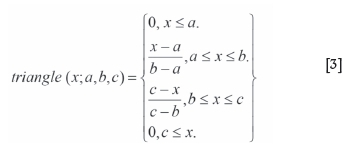
where the parameters {a, b, c} (with a <b < c) are the parameters of the linguistic value that determine the x coordinates of the three corners of the underlying triangular membership function, and x is the range of the input parameters.
The knowledge base includes the definition of the linguistic variables and their terms (fuzzy sets) and the (fuzzy) production rules and represents all the 'knowledge' for the solution of the given problem (Kirschfink and Lieven, 1999). Fuzzy rules are formed on the basis of previous experience and acquired knowledge.
The FIS, also known as the decision-making unit, performs inference operations on the rules (Ghasemi et al., 2012). The fuzzy inference process combines membership functions with the control rules to derive the fuzzy output (Bai et al., 2006). The most commonly used FISs are the Mamdani fuzzy model, Takagi-Sugeno-Kang (TSK) fuzzy model, and Tsukamoto fuzzy model. The differences between these FISs relate to the consequences of their rules. The model developed in this paper is based on Mamdani's fuzzy inference system.
An example of a Mamdani inference system (Knapp, 2004) is shown in Figure 2. The computation of the output of this FIS given the inputs, involves six steps:
1. Determining a set of fuzzy rules
2. Fuzzifying the inputs using the input membership functions
3. Combining the fuzzified inputs according to the fuzzy rules to establish a rule strength
4. Finding the consequence of the rule by combining the rule strength and the output membership function
5. Combining the consequences to obtain an output distribution
6. Defuzzifying the output distribution (only if a crisp output (class) is needed).
Defuzzification is a process of converting the fuzzy output value into a crisp value. A crisp value is extracted from a fuzzy set as a representative value. This is the opposite process to fuzzification. Because crisp values are usually needed in practical applications, the process of defuzzification is necessary.
There are many methods of defuzzification: methods employing the centroid of an area, bisector of an area, mean of maxima, smallest of maxima, and largest of maxima. The most widely used defuzzification method uses the centroid of an area described by

(Jang, 2013), where μA(Z) is the aggregated output membership function.
The application of fuzzy logic in solving problems from the real world in many fields has been described by Ghasemi et al. (2012), Grima and Babuska (1999), Gokceoglu, (2002), Gokceoglu and Zorlu (2004), Iphar and Goktan (2006), Tzamos and Sofianos (2006), Fisne et al. (2010), and Ghasemi et al. (2011).
Fuzzy modelling
Input variables for fuzzy modelling
Input variables were collected during the drilling of two blasting rounds. A total of 64 measurements were made. Within the same blasting field, different types of rock were found with values of uniaxial compression strengths listed in Table I.
The blast-holes were drilled with a rotary Bucyrus-Erie 45 R drill rig. The technical specifications of the rig are given in Table II.
The blast-hole diameter was 97/8 inches (251 mm). During the drilling, the feed force, rotary speed, and pure drilling time were recorded as well as the depth of each blast-hole. These values differ depending on the rock type. The penetration rate was estimated by dividing the blast-hole depth by the measured pure drilling time. The statistics of the collected data are given in Table III.
Fuzzy model
As already mentioned, the fuzzy model for the prediction of the penetration rate of tricone rotary blast-hole drilling is based on the Mamdani algorithm. It was developed using the MATLAB fuzzy logic toolbox (R2011a) (Jang and Gulley, 2002). The model has five input variables and one output variable, collected during the drilling of blasting rounds in the open pit mine. Input variables are the hole length (HL), pure drilling time (PDT), feed force (FF), rotary speed (RS), and uniaxial compression strength (UCS). The output variable is the penetration rate (PR). Fuzzification is realized using triangular membership functions. The membership functions and their parameters are presented in Table IV.
Figures 3 and 4 show a graphical representation of the triangular membership functions of the input variables: HL, PDT, FF, RS, and UCS.
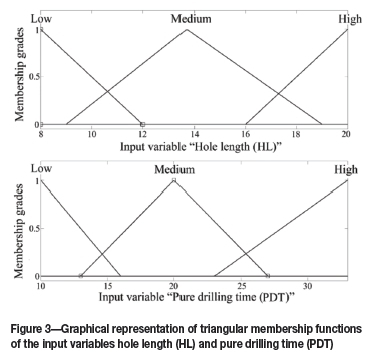
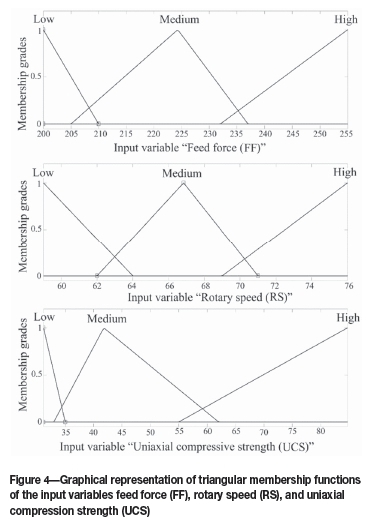
The graphical representation of the triangular membership function of the output variable (i.e. the PR) is presented in Figure 5.
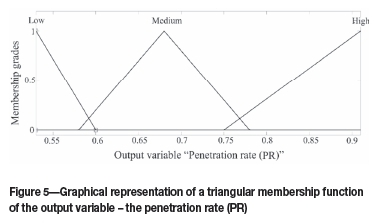
About 77% of the collected data was used to construct 118 fuzzy rules. Previous experience and knowledge were also very useful in this construction. The final process of defuzzification, where each result in the form of a fuzzy set was converted into a crisp value, was realized employing the centroid-of-area method.
Figure 6 shows the fuzzy rule viewer of the fuzzy model. As seen in Figure 6, when entering certain values of input parameters (HL, PDT, FF, RS, and UCS), the fuzzy model provides a proper value of the output variable - the PR.
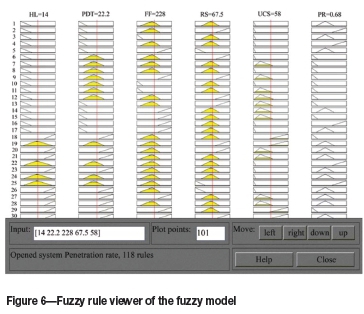
Figures 7 and 8 show the MATLAB Surface Viewer representation of the PR versus RS and FF and the PR versus the UCS and FF, respectively.
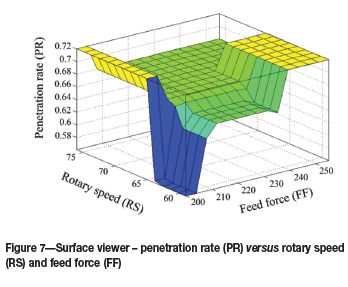
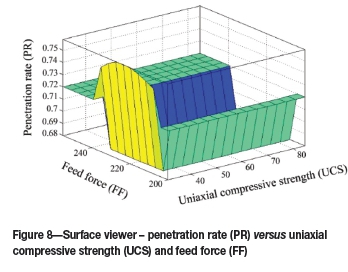
Testing the fuzzy model
The fuzzy model was tested with approximately 23% of the total data-set. Data with different values of input parameters was chosen from both blasting rounds to increase the representativeness. The graph presented in Figure 9 shows the difference between the measured and predicted values of the penetration rate. The coefficient of correlation between these two sets of data is 0.72. The results show the high reliability of the fuzzy model in predicting the values of the penetration rate, considering the number of data.
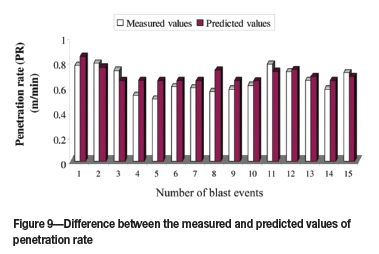
Discussion
The fuzzy model proposed for predicting the penetration rate is obtained from five important input parameters: hole length, pure drilling time, feed force, rotary speed, and uniaxial compressive strength. The last parameter characterizes the working conditions, whereas the others are related to drilling technology. The results obtained in model testing, presented in Figure 9, show the high prediction reliability of the model. The practical application of this model is the setting of drilling parameters and the optimization of the penetration rate, especially in early phases of planning drilling operations in open pit mines with similar working conditions and drilling technology. It should be noted that the quantity of the collected data directly affects the accuracy of the prediction. Therefore, the fuzzy model should be subjected to further modification and adaptation as the number of collected data increases.
Limitations of the model are related to the application of the model in other open pit mines in the cases where the drilling technology or the rock properties are quite different. Nevertheless, the methodology applied in forming this model is applicable in many other cases. The fuzzy model was formed without another important parameter - the diameter of the tricone bit - because the data was collected for blasting rounds where the diameter of tricone bits was the same. In other cases, the fuzzy model must include the diameter of the tricone bit as another input variable.
Despite the noted limitations, the proposed model can be used to predict the penetration rate of tricone rotary blast-hole drilling in open pit mines where the properties of rock formations vary widely within the same blasting round.
Conclusions
The penetration rate is an important parameter in tricone rotary blast-hole drilling. It directly affects the efficiency and productivity of the whole mining operation. Therefore, adjusting all factors that affect the rate of bit penetration to obtain optimal penetration for the given working conditions is an essential part of drilling operations. There are many empirical equations for prediction of the penetration rate. More reliable predictions are given by drill bit and drill rig manufacturers or laboratories for rock testing according to their own experience.
The application of fuzzy modeling presented in this paper provides a method for the reliable prediction of the penetration rate of tricone rotary blast-hole drilling. The accuracy of prediction of 72% is relatively high considering the number of measurements. It is obvious that the proposed fuzzy model can be improved upon with more data obtained from further drilling operations.
Acknowledgement
The authors thank the Serbian Ministry of Education, Science and Technological Development for their support of the present study and the Project of Technological Development TR33003.
References
Aquila Mining Systems. 2004. Aquila Mining Systems Products. Montreal, http://www.aquilamsl.com/frameset2.html [Accessed 1 July 2013]. [ Links ]
Atlas Copco. 2009. Blasthole Drilling in Open Pit Mining. 1st edn. p.155. www.atlascopco.com/blastholedrills [Accessed 1 July 2013]. [ Links ]
Bai, Y., Zhuang, H., and Wang, D. 2006. Fundamentals of fuzzy logic control -fuzzy sets, fuzzy rules and defuzzifications. Advanced Fuzzy Logic Technologies in Industrial Applications, XXV. Springer. 334 pp. [ Links ]
Bauer, A. 1967. Open pit drilling. Proceedings of the 28th Annual Mining Symposium, Duluth, MN. pp. 175-180. [ Links ]
Bauer, A. 1971. Open pit drilling and blasting. Journal of the South African Institute of Mining and Metallurgy, vol. 71. pp. 115-121. [ Links ]
Bucyrus-Erie. 1966. Bucyrus Erie 45-R Rotary Drill. Instruction Manual, Bucyrus-Erie Company, South Milwaukee, Wisconsin, USA. [ Links ]
Bugarin, M., Maksimovic, M., and Ljubojev, V. 2012. Reserves of copper and gold in exploration - exploitation field RTB Bor. Serbian Journal of Mining Engineering, no. 3. Mining and Metallurgy Institute, Bor. pp. 1-16. doi:10.5937/rudrad1203001B [ Links ]
Fisne, A., Kuzu, C., and Hudaverdi, T. 2010. Prediction of environmental impacts of quarry blasting operation using fuzzy logic. Environmental Monitoring and Assessment. [Epub ahead of print]. DOI: 10.1007/s10661- 010-1470-z [ Links ]
Ghasemi, E., Ataei, M., and Shahriar, K. 2011. Prediction of roof fall rate in coal mines using fuzzy logic. Proceedings of the 30th International Conference on Ground Control in Mining, University of West Virginia, Morgantown, WV. pp. 186-191. [ Links ]
Ghasemi, E., Ataei, M., and Hashemolhosseini, H. 2012. Development of a fuzzy model for predicting ground vibration caused by rock blasting in surface mining. Journal of Vibration and Control. doi: 10.1177/1077546312437002 [ Links ]
Gokceoglu, C. 2002. A fuzzy triangular chart to predict the uniaxial compressive strength of Ankara agglomerates from their petrographic composition. Engineering Geology, vol. 66, no. 1-2. pp. 39-51. [ Links ]
Gokceoglu, C. and Zorlu, K. 2004. A fuzzy model to predict the uniaxial compressive strength and the modulus of elasticity of a problematic rock. Engineering Applications of Artificial Intelligence, vol. 17, no. 1. pp. 61-72. [ Links ]
Gokhale, B.V. 2003. Blasthole drilling technology. Multi Fields, Mumbai, India. [ Links ]
Grima, M.A. and Babuska, R. 1999. Fuzzy model for the prediction of unconfined compressive strength of rock samples. International Journal of Rock Mechanics and Mining Sciences, vol. 36, no. 3. pp. 339-349. [ Links ]
Iphar, M. and Goktan, R. M. 2006. An application of fuzzy sets to the Diggability Index Rating method for surface mine equipment selection. International Journal of Rock Mechanics and Mining Sciences, vol. 43, no. 2. pp. 253-266. [ Links ]
Jang, J-S.R. 2013. Fuzzy inference systems. http://xa.yimg.com/kq/groups/22940872/1444236568/name/cHAPTER+4.pdf [Accessed 1 July 2013]. [ Links ]
Jang, J-S.R. and Gulley, N. 2002. Matlab Fuzzy logic toolbox. The MathWorksInc. [ Links ]
Jimeno, C.L., Jimeno, E.L., and Carcedo, F.J.A. 1995. Drilling and Blasting of Rocks. Balkema, Rotterdam. [ Links ]
Kaehler, S.D. 1998. Fuzzy logic - an introduction, Part 1. Encoder. Seattlerobotics, http://www.seattlerobotics.org/encoder/mar98/fuz/fl_part1.html [Accessed 1 July 2013]. [ Links ]
Kirschfink, H. and Lieven, K. 1999. Basic Tools for Fuzzy Modeling. Heribert Kirschfink, Aachen, Germany. http://citeseerx.ist.psu.edu [Accessed 1 July 2013]. [ Links ]
Knapp. 2013. Fuzzy inference systems. http://www.cs.princeton.edu/courses/archive/fall07/cos436/HIDDEN/Knapp/fuzzy004.htm [Accessed 1 July 2013]. [ Links ]
Kricak, L. 1997. Research on the influence of rock mass parameters on the choice of the type of tricone bits. PhD thesis, Faculty of Mining and Geology, University of Belgrade, Serbia (in Serbian). [ Links ]
Mitrovic, S. 2005. Model for managing the explosion effect in order to get the required fragmentation of the muck pile. PhD thesis, Faculty of Mining and Geology, University of Belgrade, Serbia (in Serbian). [ Links ]
Modular Mining Systems. 2002. Provision™ Drill Technical Bulletin. http://www.mmsi.com [ Links ]
Praillet, R. 1984. Consideraciones de un Fabricante de Máquinas de Perfóracion. Canteras y Explotaciones, September 1984. [ Links ]
Sharma, P.D. 2012. Measurement while drilling (MWD) and image analysis systems. Today's most useful and cost-effective tools for mining industry, mining and blasting. http://miningandblasting.wordpress.com/ [Accessed 1 July 2013]. [ Links ]
Tamrock. 1984. Handbook on surface drilling and blasting. Painofaktorit, Finland. pp. 260. [ Links ]
Tzamos, S. And Sofianos, A.I. 2006. Extending the Q system's prediction of support in tunnels employing fuzzy logic and extra parameters. International Journal of Rock Mechanics and Mining Sciences, vol. 43, no. 6. pp. 938-949. [ Links ]
Paper received Aug. 2013
Revised paper received May 2015















